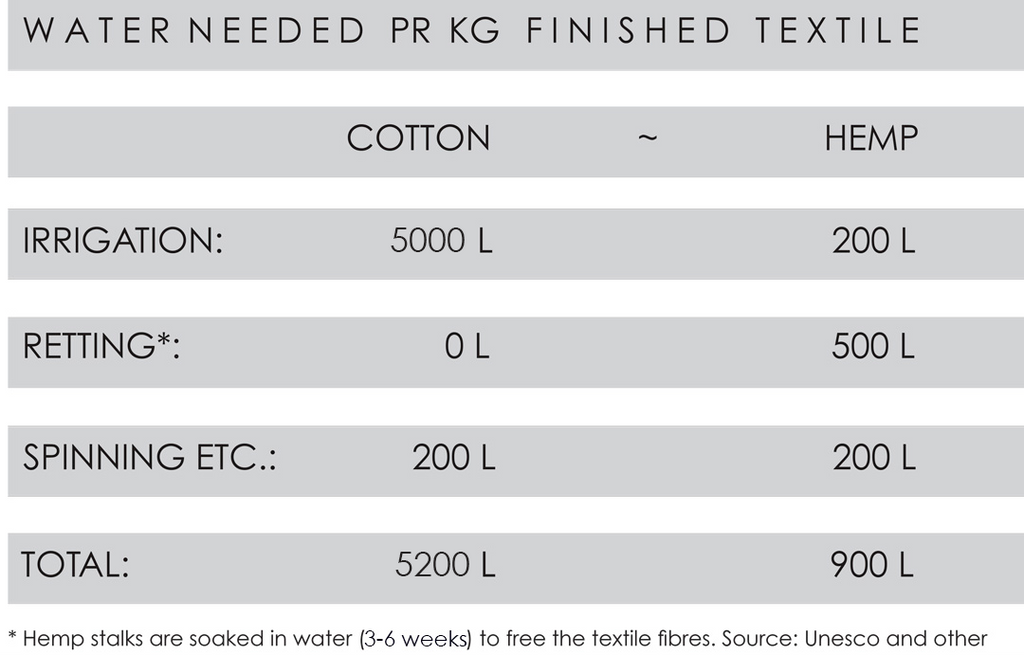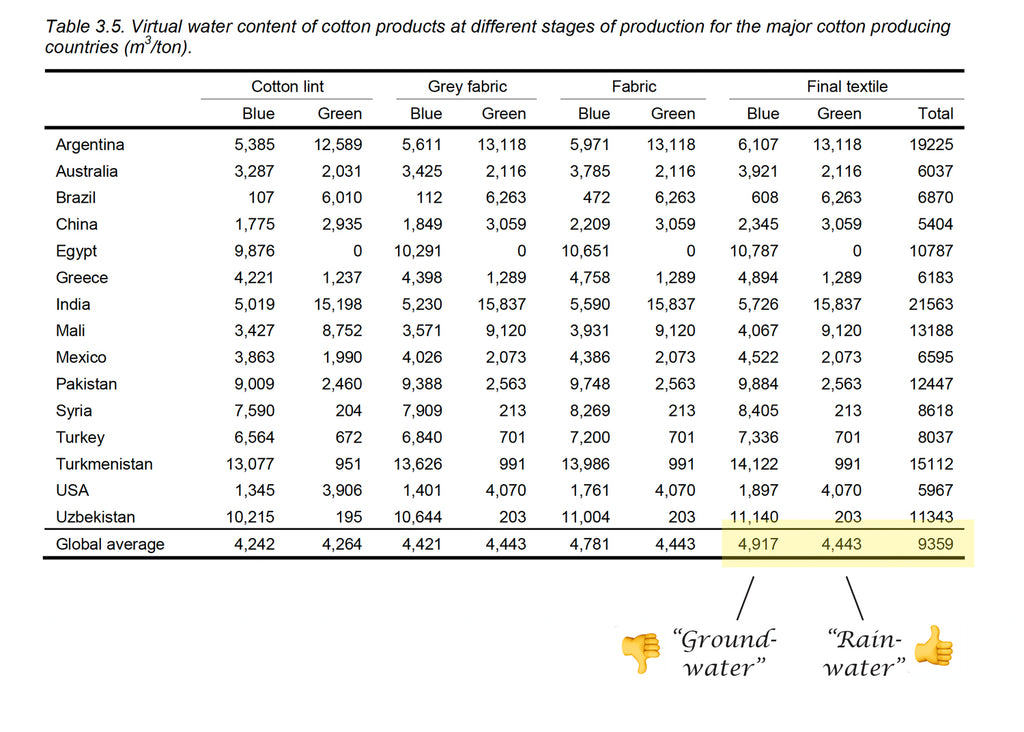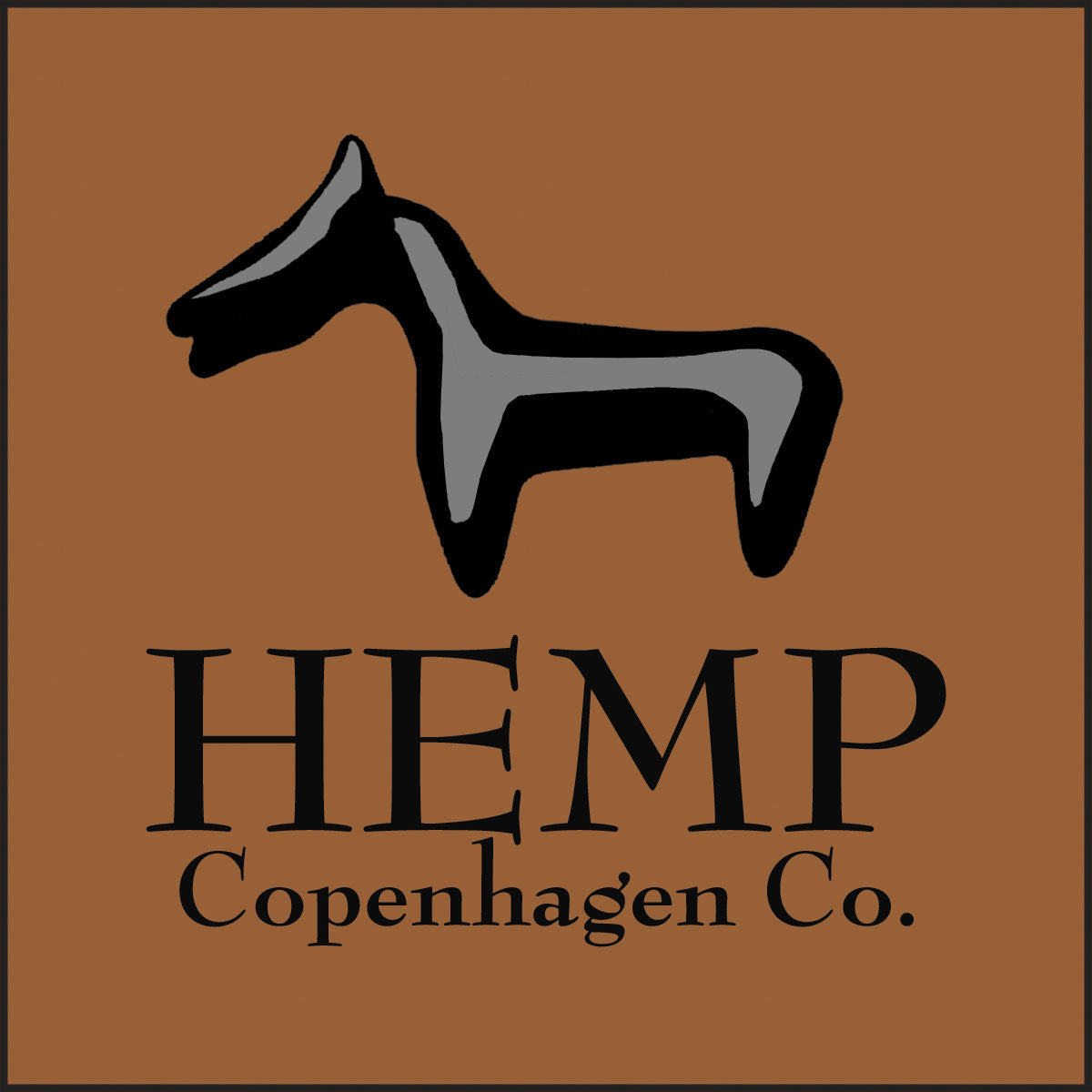Hemp Science
"Is hemp organic?" - "Is water wet?"
The main assurance that hemp always is organic is the lack of incentives to use chemicals to increase the yield of a hemp field. Industrial hemp repels most insects, fungi and microbes, making the use of herbicides and pesticides useless.
So, if it is real hemp, it is organic by definition - or rather by Nature!
By the same reason, not all hemp producers are organically certified, e.g. with GOTS. Most producers would probably ask if they should also certify that their water is wet? - We trust our producers; but first and foremost we trust in the natural properties of hemp – a better guarantee than all manner of certificates.

Sustainable? Absolutely!
It only requires about 1/3 land and 0-5% water to grow industrial hemp, compared to cotton. Cotton requires an average of 10,000 liters of water per. kg of fiber (grown on 3.4 m2). The 5000 liters are handled by "Green" water, ie. precipitation Hemp requires only 2000 liters per kg, ie. far below average rainfall. Sources: UNESCO LINK and others. Figures are global averages.
Summary of hemp sustainability factors vs. other natural textiles here.
Water-footprint, entire production chain
Hemp requires quite a lot of water for retting. Cotton does not. So to be fair on the water comparison, we need to look at the entire production chain. However, it does not really change the picture...

* Retting: Hemp stalks are soaked in water for 4-6 weeks to free the fibers. Research show that retting only costs 122 L/kg. All figures are global averages. Source Unesco-EHI.
Hemp - a fantastic CO2-absorber!
Both Hemp´s CO2 footprint and water footprint is much smaller than for other natural textile fibers.
Hemp absorbs 22-44 tons of CO2 per hectare per hectare. years (44 tons, at two harvests per season), far more than a mature forest and 4 times more than cotton.
Cotton - and organic cotton - use a lot of water
Cotton has a natural need for approx. 10,000 liters of water per. kg fiber. UNESCO figures, etc. shows that approx. half of this is covered by "Green Water" - ie precipitation or rain. This means "Blue Water Consumption" or "Groundwater-Consumption" from lakes and wells is around 5000 liter per kg cotton fiber (= 4917 L in the table, below).
Hemp's total needs, on the other hand, are approx. 2000 liters pr. kg fiber, ie well below the "average" Green Water level.

Source: UNESCO "The water footprint of cotton consumption", p. 18
In addition, just over 90% of the world's cotton production is not organic. This means that pesticides are washed out into the groundwater, which further reduces the amount of clean, usable water. It goes without saying that, at 25 billion kg of cotton produced annually, much water and chemicals can be saved by increasing the share of hemp textile production.
If hemp is so sustainable, why is it so pricy?
Short answer: Labour, not scarce natural resources, like land and water. Normally, expensive products are expensive because they require more resources . The production of hemp textile requires much fewer scarce resources: land and water, against more use of "abundant" resources: labor. On the other hand, cotton requires 3 x land and + 5000 L irrigated water per kilo fibre.
Large amounts of labour goes into the production of hemp. First, the 2-4 meter high stalks are cumbersome to harvest, with no ideal harvesting equipment. Then the stalks has to be gathered in bundles and dried for a week. Next, the stalks must be "retted". The stalks are soaked in water for 4-6 weeks, so you can free the fibres from the stalk. All this is done and monitored manually.
Hemp is antibacterial – Really ?
Yes, Hemp fabric is antibacterial and hypoallergenic by nature. Cotton is not.
You may remember a hemp glove in the bathroom that never goes mouldy. This is not true for cotton towels. There is also clear scientific research that show impressive antibacterial properties of hemp:
 One reason is CBD 1), which scientists and dermatologists believe can help to "close" the skin, so that antioxidants are rejected so that the skin ages less and various irritations are reduced. Another very important reason is THC (the substance you can get high from if you smoke Marijuana-Hemp) in the fibers simply repels most animals, fungi and bacteria - and possibly also dust mites. Dust mites are proven to be associated with certain allergies, including asthma. Studies show that bacteria such as Staphylococci, Coli and Candida can disappear within a few hours (see above and Ref. 2). This does not apply to cotton, which can house bacteria and vermin for weeks (Ref. 2).
One reason is CBD 1), which scientists and dermatologists believe can help to "close" the skin, so that antioxidants are rejected so that the skin ages less and various irritations are reduced. Another very important reason is THC (the substance you can get high from if you smoke Marijuana-Hemp) in the fibers simply repels most animals, fungi and bacteria - and possibly also dust mites. Dust mites are proven to be associated with certain allergies, including asthma. Studies show that bacteria such as Staphylococci, Coli and Candida can disappear within a few hours (see above and Ref. 2). This does not apply to cotton, which can house bacteria and vermin for weeks (Ref. 2).
What does all this mean for you as a consumer?
Firstly, you can shop hemp textile with an unheard amount of pure conscience In addition to hemp's fantastic product properties:
Secondly, Hemp fabric is three times stronger than cotton and linen. The fibers run the entire length of the stem and are cut down to 8 cm for spinning. (Egyptian cotton has a maximum of 4 cm long fibers). Hemp fabric absorbs moisture 30% better than cotton. The "hollow" fibers also provide good insulation and provide good UV-protection.
As hemp is antibacterial, you do not need to wash it as often and you can wash at lower temperatures (30-40 ° C). Moreover, towels and dishcloths etc. do not get sour or mouldy.
The antibacterial properties mean, if you sleep in hemp bedding, dry yourself with hemp towels, etc., there is a good chance you will experience fewer rashes, allergies. You or your children may even be saved from asthma.
.. and what does it mean for us all as responsible consumers?
Well, we need to get rid of all conventional cotton production. Besides using a lot of water, it uses a lot of chemicals. So, we need to stop buying conventional cotton products. However before you automatically switch to organic cotton, which still uses a lot of water and land, consider hemp.
– Or at least, consider a 50-50 blend of hemp and organic cotton. If everybody did that, that would take us somewhere!
See also our article on Sustainability.
References:
1) Advances in the Performance and Application of Hemp Fiber pdf
2) Survival of Enterococci and Staphylococci on Hospital Fabrics and Plastic pdf
3) Production process, Hemp Copenhagen, Transsylvania.
Hemp - Further research:
We support the Danish project Hemp4Tex (LINK), which among other things aims to develop better harvesting machines as well as faster and cheaper reddening via environmentally friendly enzyme treatment.
Our own research, after sleeping in hemp bedding during the year, is quite promising. That the fabric is really antibacterial, however, is quite clear: neither our own nor customers' towels get sour or mouldy, no matter what they are exposed to.
DECLARATION OF AUTHENTICITY AND MATERIALS USED:
We declare our product are produced of 100% hemp textile, unless otherwise stated. Other materials used can be organic cotton, used as backing for our terry towels or recycled polyester-fibre, used as fast-drying fillings in e.g. sleep bags and playing mats. Certificates of authenticity and production methods from our suppliers can be produced to relevant authorities. Dyes used, if any, are GOTS-certified.
DISCLAIMER:
The many virtues of hemp and hemp textile are documented and agreed upon by most industry and scientific authorities - as well as by many consumers by experience. However, we cannot in any way or form guarantee that babies, infants or adults will experience improved health, better sleep or fewer allergies as a result of using our products. Other factors can greatly influence both physical condition and quality of sleep. For a better life and better sleep you should always make sure you and your family exercise sufficiently and adhere to a healthy diet. You should always follow the advice of your physician/MD and other reckognised authorities in these matters.

